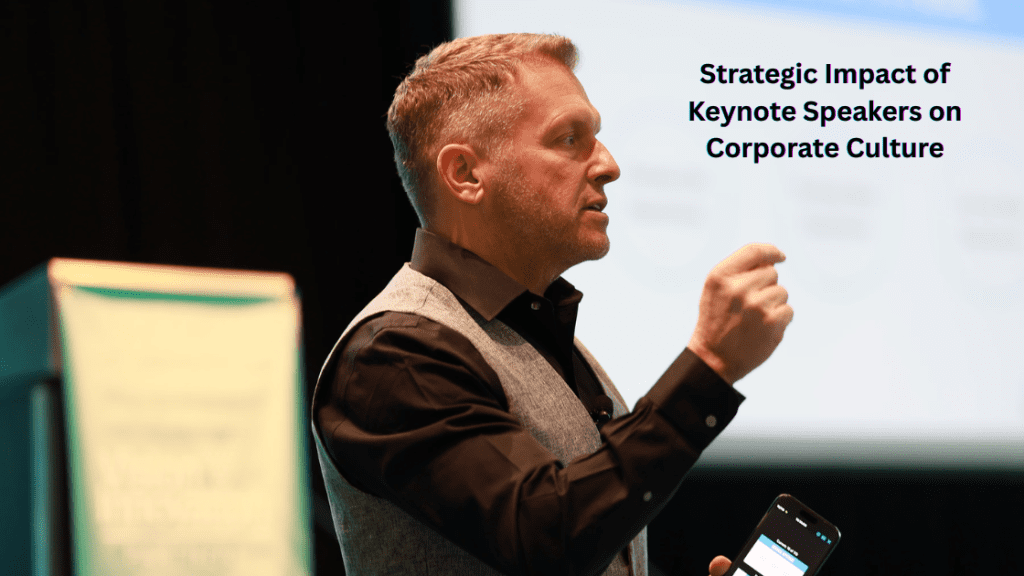Gallup’s most recent data revealed that only about 31–32% of American employees reported being engaged at work. 17% of them reported being actively disengaged. A strong, positive corporate culture is key to retaining and motivating your team. This is why organizations are increasingly turning to keynote speakers to inspire and align their employees.
The Evolving Role of the Business Keynote Speaker
General motivational stories no longer “fire up” employees. A corporate keynote speaker now takes on a more sophisticated approach that involves understanding the company’s unique challenges and addressing them with targeted, strategic insights that leave a lasting impact.
It is much more than a one-time event. It’s a strategic intervention that provides a framework to solve and prevent corporate culture issues in the company.
A business keynote speaker can directly combat the disengagement and lay down a foundation for a more engaged, proactive workforce.
The Pillars of a Powerful Keynote Speaker
Inspiring and Motivating a Shared Vision
One key role of a keynote speaker is to connect goals to a deeper purpose. Your team needs a shared vision so compelling that they feel driven to become an integral part of it. A good keynote speaker precisely articulates the “why” behind that shared vision.
Aligning Values with Action
The gap between a company’s professed values and actual actions undermines authenticity and erodes trust. Clearly defining the core values as actionable behaviors and demonstrating them through daily decision-making and actions helps define the culture and drives collective success.
From Generic Advice to Actionable Strategy
The Power of Concrete Examples
A strategy truly sticks when it is grounded in reality. A corporate keynote speaker uses concrete examples and compelling case studies to provide tangible and understandable abstract ideas. By illustrating how a particular strategy works in practice, the speaker provides a powerful blueprint you can apply to enhance your corporate culture.
The Pre- and Post-Event Blueprint
View a keynote event as a crucial component of a broader initiative aimed at fostering and sustaining a thriving corporate culture. Ensure the speaker collaborates with you before the event to understand your corporate culture, challenges, and desired outcomes. This helps precisely tailor content for your organization.
After the event, have a plan to reinforce the core takeaways through follow-up discussions, workshops, and training. A single event can lead to a sustained cultural change.
The Strategic Approach to Risk Management
The Risk of a Mismatch
Imagine you invite a keynote speaker who advocates for high-pressure, aggressive sales tactics, but you value collaboration and long-term relationships with your customers. This mismatch can create confusion and erode employees’ trust in the leadership.
The Peril of a Short-Lived “Sugar Rush”
Temporary excitement and energy fade away quickly when the impact is not lasting. This happens when a keynote lacks actionable insights and a follow-up plan. A successful keynote is integrated into a broader initiative that provides a framework for sustained growth.
Actionable Steps
You need a systematic approach for vetting keynote speakers who align with your corporate culture.
- Clearly articulate the challenges you want to address and the desired cultural outcomes.
- Ask for their case studies, published work, and a sample of presentations.
- Check their references.
- Assess their personal brand and values.
- Engage in a detailed conversation with them about your pre- and post-event strategy.
Capitalizing on Opportunities: The Long-Term ROI
New Era of Workplace Culture
The modern corporate culture is purpose-driven, empathetic, and resilient. Employees want to know that their work makes a difference, and they want to feel a sense of belonging.
It’s a new era that requires leaders to build a culture that prioritizes psychological safety, continuous learning, and adaptability.
Measuring the Unseen: From Surveys to Sentiment
Use employee surveys with specific questions to measure the impact of the keynote. Conduct sentiment analysis to gauge changes in employee morale and trust. Track key performance indicators like turnover and project completion rates as an elevated corporate culture motivates employees to excel, leading to better outcomes.
Conclusion
A powerful keynote is a strategic tool for cultural transformation. When you choose a corporate keynote speaker who aligns with your company’s values and provides an actionable blueprint, a single event can be the foundation you need for sustained growth, engagement, and success.
Frequently Asked Questions
- How do we measure the ROI of a keynote speaker?
Use surveys and sentiment analysis on internal communications to track how the speaker’s message translates into tangible changes in employees’ morale, trust, communication, and overall corporate culture. Employee turnover and project completion rates are clear indicators of an engaged and productive workforce and cultural health.
- How do we choose the right speaker for our company culture?
Define your company’s values and goals you want to achieve with the event. Check references, assess the personal brand, and review the content of the speaker. Make sure that the message and style of the speaker are aligned with your corporate culture.
- Is a keynote speaker a one-time solution for cultural problems?
No, you need to sustain the impact of the keynote through follow-up workshops and discussions to reinforce and integrate the message into daily operations.
- What’s the difference between a motivational speaker and a business keynote speaker?
A motivational speaker shares general stories to provide a temporary motivational boost. A corporate keynote speaker, on the other hand, provides targeted, actionable insights to solve specific corporate challenges. You get a robust framework for a lasting cultural change.
